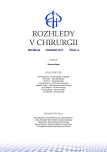Ruptures of the diaphragm
Authors:
J. Schützner; J. Šimonek; A. Stolz; J. Kolařík; J. Pozniak; V. Bobek; P. Pafko; R. Lischke
Authors‘ workplace:
III. chirurgická klinika 1. LF Univerzity Karlovy, FN Motol, Praha
přednosta: prof. MUDr. R. Lischke, PhD.
Published in:
Rozhl. Chir., 2017, roč. 96, č. 12, s. 493-497.
Category:
Review
Overview
Introduction:
The diaphragm is a flat muscle that divides the thoracic and abdominal cavities, and it is one of the most important muscles involved in respiration. Traumas of the diaphragm include its rupture caused by an external force, resulting in blunt or penetrating injuries. Diaphragmatic rupture is associated with the risk of a prolapse (i.e. not a typical hernia) of abdominal organs into the pleural cavity. The rupture may occur due to a blunt injury of the chest or abdomen, or due to penetrating injuries (gunshots, stab wounds, foreign bodies) in the lower part of the chest and epigastrium. Ruptures never heal spontaneously and always require suture of the diaphragmatic defect.
Most acute rupture cases are managed using laparotomy; thoracotomy is preferred for lately recognised ruptures to facilitate the removal of adhesions in the thoracic cavity developed between the diaphragmatic defect and a lung.
Thirty one patients with diaphragmatic rupture were operated at the 3rd Department of Surgery of the 1st Faculty of Medicine, Charles University and University Hospital Motol between 2006 and 2016. Acute rupture was present in 60% of the cases and chronic in 40%. Right-sided rupture was found in 20% and left-sided in 80%.
Conclusion:
The authors describe surgical treatment of diaphragmatic ruptures. They recommend an early surgical treatment if diaphragmatic rupture is recognized. Generally, the prognosis of the patients depends on availability of professional health care; ideally, these patients should be treated at specialised traumacentres with specialists for abdominal and thoracic surgery. The authors advise against establishing injudicious thoracic drainage in cases where diaphragmatic rupture with herniation of abdominal organs into the thorax may be present.
Key words:
polytrauma – acute rupture of diaphragm – chronic rupture – suture – patch
Sources
1. Dirican A, Yilmaz M, Unal B, et al. Acute traumatic diaphragmatic ruptures: A retrospective study of 48 cases. Surg Today 2011;41:1352−6.
2. Shields TW, LoCicero III J, Reed CE, et al, General thoracic surgery. Seventh edition. Philadelphia, Lippincott Williams & Wilkins 2009.
3. Hájek M, a spol. Traumatologie hrudníku. Praha, Avicenum 1980.
4. Jana M, Hari S. Traumatic diaphragmatic rupture complicated by intercostal tube insertion into the stomach. Surgery 2011;150:570−1.
5. Kitka M. Poranenia bránice. Slovenská chirurgia 2016,13:3−4,65−6.
6. Pearson FG, et al. Thoracic surgery. Second Edition. Philadelphia, Churchill Livingstone 2002.
7. Petrone P, Leppaniemi A, Inaba K, et al. Diaphragmatic injuries: challenges in the diagnosis and management. Trauma 2007;9:227–36.
8. Šimánek V, Třeška V, Klečka J, et al. Pozdně diagnostikovaná ruptura bránice – kazuistika. Rozhl Chir 2009;88:262−3.
9. Vyhnánek F, Jirava D, Skála P, et al. Spektrum poranění bránice ošetřené v traumatologickém centru. Rozhl Chir 2011;90:377−81.
Labels
Surgery Orthopaedics Trauma surgeryArticle was published in
Perspectives in Surgery

2017 Issue 12
Most read in this issue
- Pulmonary contusion
- Ruptures of the diaphragm
- Myxoid liposarcoma localised in the peritoneal cavity − case report
- Chest injuries in polytraumatized children
